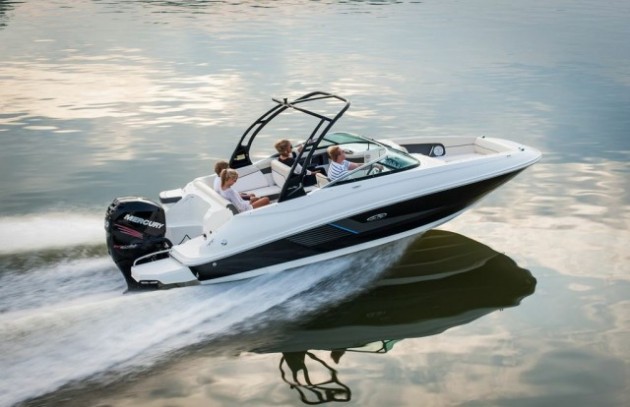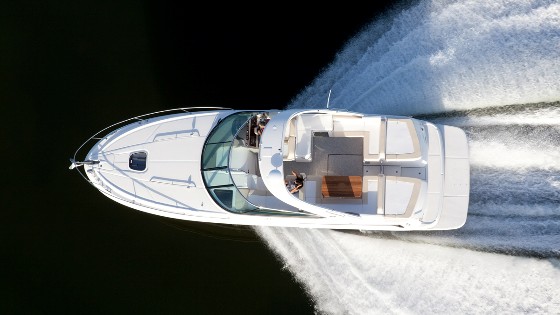Outboard Engines on Bowriders: A Match Made in Heaven?
Outboard engines are becoming more and more prevalent on bowriders, a boat type that used to come only with a stern-drive. Why? And, is this a good thing?
If you’ve been shopping for bowriders recently, you probably noticed a lot more are being offered with outboards these days. With this type of boat, stern-drives have always ruled the roost. Yet we’ve seen new model introductions from heavy-hitters like Bayliner (the Bayliner Element, Element XR7, the 170 Bowrider, and the 210 DB) and Sea Ray (the 220 Sundeck OB, and the 240 Sundeck) which all eschew the old innie-outie for outboard power. In fact, outboards have even encroached into the world of high-performance boats (like the Baja 26 Outlaw).
What gives? Why are outboards showing up on these types of boats, and more importantly, should you consider one for your new ride?
Money Talks
The biggest single factor boils down to cost. While stern drives used to hold an advantage in this regard, in many cases today they don’t. It isn’t that outboards have become any cheaper—stern drives have just become more expensive. This is due to the latest environmental laws, which made a catalytic converter a required piece of equipment on stern drives. This adds quite a bit of cost, and in the case of the Bayliner 170, for example, means the outboard version goes for around $1,000 less than a comparably-equipped stern-drive version. That’s about a five-percent difference; probably not a deal-killer for most boat buyers, but still significant.
Then there are maintenance costs to figure in. Today’s outboards are shockingly reliable, and more importantly, eliminate the need for a lot of mechanical pieces and parts that are necessary with a stern-drive. Getting power to the prop is much simpler. And there’s no boot, to boot.
What about operational costs? In that regard, stern-drives sometimes hold an advantage. For a head-to-head comparison, look at that Sea Ray 240 Sundeck. We tested this platform with a 300 HP Mercury Verado and a 300 HP MAG 350 Bravo III stern-drive, and at a cruising speed of around 35 MPH the stern-drive got 0.3 more miles to the gallon. At speeds over 45 MPH, however, the outboard overtook the stern-drive for fuel efficiency.
Performance Particulars
Another area in which outboards now hold an advantage is performance. Remember that head-to-head comparison we just mentioned? With the Verado on the transom, that Sea Ray hits 59.6 MPH. But in its traditional form, the boat tops out at 49.8 MPH. That’s quite a difference. Yes, outboards do spin up to higher RPM ranges, but in no small part the speed difference also comes from the weight-savings. In this case, the outboard boat is around 19 percent lighter—a huge difference (more on how this weight-savings changes the boat in a moment).
In many cases, outboard power also delivers improved handling at slow speeds. Especially in the case of single-prop drives (as opposed to dual-prop drives like the Volvo-Penta DuoProp or the Bravo III), stern-drive boats tend to wander quite a bit as you putt-putt through the idle zones.
Even more important to many of us, the speed and handling delivered by the outboard is simply more pleasant, due to a significant reduction in sound and vibration levels. Today’s four-stroke outboards are so quiet that at idle you can barely tell they’re running. And at high speeds there’s often more wind noise than engine noise. This difference is more or less important to different people, so there’s only one way to figure out just how it should play into your boat-buying decision: run both versions of the boat, and make the call for yourself.
Second Thoughts
Before you get too charged up at the thought of running an outboard-powered bowrider, it’s time for a reality check. Yes, these rigs have plenty of advantages but they have some distinct disadvantages, too. First and foremost, that weight “advantage” changes the feel of the boat underfoot, and not necessarily for the better. Sure, it’s lighter and faster. But all that weight low down in the aft end of the stern-drive model helps it to punch through the waves with a bit more authority. I don’t have a way to quantify this phenomenon, but my gut tells me that stern-drive versions of otherwise identical boats run eight to 10 percent more smoothly in chop.

With a lot more heft, the stern-drive version of the Sea Ray 240 is (in the author's opinion) better able to punch through waves.
Stern-drives also hold an advantage when it comes to entertaining; they have larger swim platforms, unbroken by an outboard right in the middle of things. You might expect to gain a lot of cockpit space when you get rid of the stern-drive, but in many cases the basic design remains the same and “saved” space is merely used for stowage and mechanicals (like pumps and batteries). This is partially due to the need for manufacturing efficiencies (most builders use the exact same deck cap for both stern drive and outboard versions of the same bowrider), but it’s a reality we have to deal with. In some other cases, you may gain a bit in the cockpit but in return, lose the sunpad provided by a motorbox.
So which is going to be better for you and your family: an outboard, or a stern-drive? That’s a decision only you can make. The good news is, now you get to look at these different advantages and disadvantages, and then make the decision for yourself.
Editor’s note: Outboards aren’t just gaining steam in the world of runabouts, they’re making inroads in cruisers, as well. For more information read Sea Ray 370 Venture: An Express Cruiser with Outboards Inside, and Pursuit SC 365i Sport Yacht: A New Direction.



















